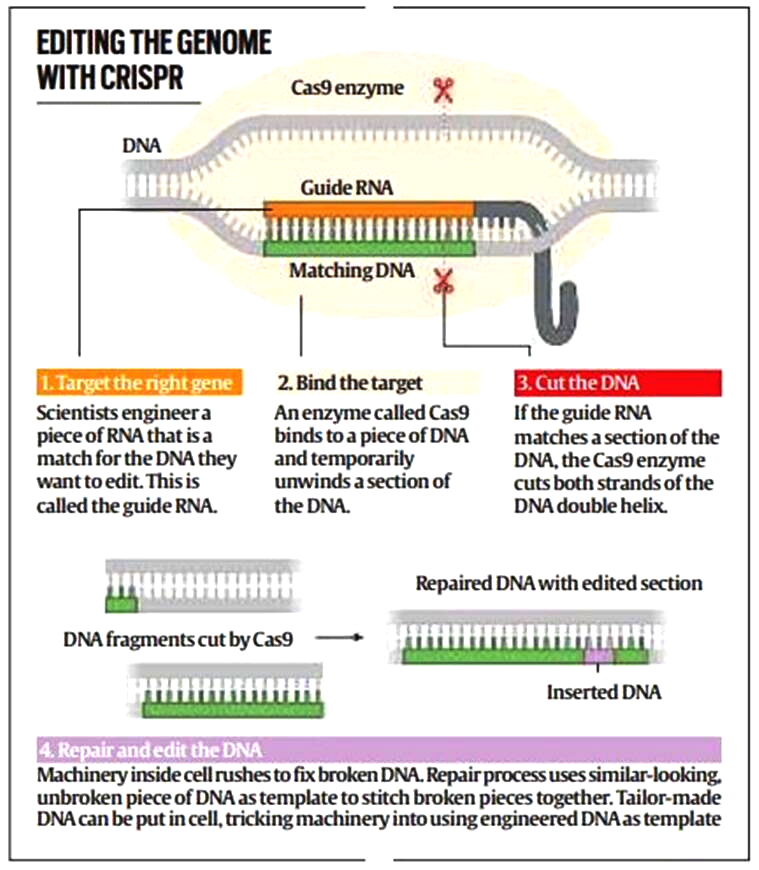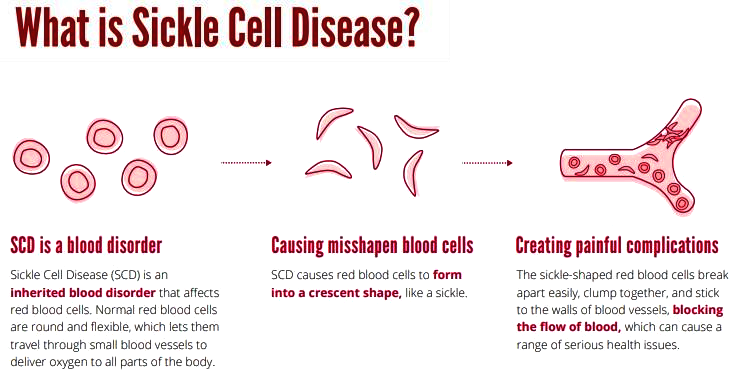CRISPR-Cas9 for Sickle-Cell Anaemia | 14 Sep 2022
For Prelims: CRISPR-Cas9, Sickle Cell Anaemia, Gene Editing, Genetic Engineering
For Mains: CRISPR-Cas9 Technology, Applications, Significance and Related Ethical Concerns
Why in News?
India approved a 5-year project to develop Clustered Regularly Interspaced Short Palindromic Repeats (CRISPR) to cure sickle cell anaemia in 2021.
- Sickle cell anaemia is the first disease that is being targeted for CRISPR-based therapy in India.
- The pre-clinical phase (trials on animal subjects) is about to begin.
What is CRISPR Technology?
- About:
- Clustered Regularly Interspaced Short Palindromic Repeats (CRISPR) is a gene editing technology, which replicates natural defence mechanism in bacteria to fight virus attacks, using a special protein called Cas9.
- It usually involves the introduction of a new gene, or suppression of an existing gene, through a process described as genetic engineering.
- CRISPR technology does not involve the introduction of any new gene from the outside.
- CRISPR-Cas9 technology is often described as ‘Genetic Scissors’.
- Its mechanism is often compared to the ‘cut-copy-paste’, or ‘find-replace’ functionalities in common computer programmes.
- A bad stretch in the DNA sequence, which is the cause of disease or disorder, is located, cut, and removed and then replaced with a ‘correct’ sequence.
- The tools used to achieve this are biochemical i.e., specific protein and RNA molecules.
- The technology replicates a natural defence mechanism in some bacteria that uses a similar method to protect itself from virus attacks.
- Mechanism:
- The first task is to identify the particular sequence of genes that is the cause of the trouble.
- Once that is done, an RNA molecule is programmed to locate this sequence on the DNA strand, just like the ‘find’ or ‘search’ function on a computer.
- After this Cas9 is used to break the DNA strand at specific points, and remove the bad sequence.
- A DNA strand, when broken, has a natural tendency to re-attach and heal itself. But if the auto-repair mechanism is allowed to continue, the bad sequence can regrow.
- So, scientists intervene during the auto-repair process by supplying the correct sequence of genetic codes, which attaches to the broken DNA strand.
- It is like cutting out the damaged part of a long zipper, and replacing it with a normally functioning part.
- So, scientists intervene during the auto-repair process by supplying the correct sequence of genetic codes, which attaches to the broken DNA strand.
- The entire process is programmable, and has remarkable efficiency, though the chances of error are not entirely ruled out.
What is the Significance of CRISPR-based Therapeutic Solutions?
- Specific Treatment: CRISPR aids in the disease treatment by correcting the underlying genetic problem. CRISPR-based therapeutic solutions are not in the form of a pill or drug. Instead, some cells of every patient are extracted, the genes are edited in the laboratory, and the corrected genes are then re-injected into the patients.
- What is to be edited, and where, is different in different cases. Therefore, a specific solution needs to be devised for every disease or disorder that is to be corrected.
- The solutions could be specific to particular population or racial groups, since these are also dependent on genes.
- The changes in genetic sequences remain with the individual and are not passed on to the offspring.
- What is to be edited, and where, is different in different cases. Therefore, a specific solution needs to be devised for every disease or disorder that is to be corrected.
- Permanent Cure of Genetic Diseases/Anomalies: A vast number of diseases and disorders are genetic in nature i.e.; they are caused by unwanted changes or mutations in genes.
- These include common blood disorders like sickle cell anaemia, eye diseases including colour blindness, several types of cancer, diabetes, HIV, and liver and heart diseases. Many of these are hereditary as well.
- CRISPR opens up the possibility of finding a permanent cure for many of these diseases.
- Deformities like stunted or slow growth, speech disorders, or inability to stand or walk arise out of abnormalities in gene sequences.
- CRISPR presents a potential treatment for the cure of such abnormalities as well.
What is the Related Ethical Dilemma?
- CRISPR’s power to induce dramatic changes in an individual which can be potentially misused.
- In 2018, a Chinese researcher disclosed that he had CRISPR aids in the disease treatment by correcting the underlying genetic problem.
- This was the first documented case of creating a ‘designer baby’, and it caused widespread concern in the scientific community.
- Preventive interventions to obtain special traits is not something that scientists currently want the technology to be used for.
- Also, because the changes were made in the embryo itself, the new acquired traits were likely to be passed on to future generations.
- Though the technology is fairly accurate, it is not 100% precise, and could induce a few errors as well, making changes in other genes. This has the possibility of being inherited by successive generations.
- In 2018, a Chinese researcher disclosed that he had CRISPR aids in the disease treatment by correcting the underlying genetic problem.
What is Sickle Cell Anaemia?
- About:
- It is an inherited blood disease which is most common among people of African, Arabian and Indian origin.
- It is a group of disorders that affects hemoglobin, the molecule in red blood cells that delivers oxygen to cells throughout the body.
- People with this disease have atypical hemoglobin molecules called hemoglobin S, which can distort red blood cells into a sickle, or crescent shape.
- This blocks blood flow and oxygen from reaching all parts of the body.
- Symptoms:
- It can cause severe pain, referred to as sickle cell crises.
- Over time, people with sickle cell disorders can experience damage to organs including the liver, kidney, lungs, heart and spleen. Death can also result from complications of the disorder.
- Treatment:
- Medication, blood transfusions and rarely a bone-marrow transplant.
UPSC Civil Services Examination, Previous Year Question (PYQ)
Prelims
Q. What is Cas9 protein that is often mentioned in news? (2019)
(a) A molecular scissors used in targeted gene editing
(b) A biosensor used in the accurate detection of pathogens in patients
(c) A gene that makes plants pest-resistant
(d) A herbicidal substance synthesized in genetically modified crops
Ans: (a)
Exp:
- CRISPR-Cas9 is a unique technology that enables geneticists and medical researchers to edit parts of the genome by removing, adding or altering sections of the DNA sequence.
- CRISPR is an acronym for “Clustered Regularly Interspaced Short Palindromic Repeats.”
- Cas9 is basically an enzyme that is used like a pair of scissors to cut two strands of DNA at a specific location to add, remove or repair bits of DNA.
- Hence, option A is the correct answer.
Mains
Q. What are the research and developmental achievements in applied biotechnology? How will these achievements help to uplift the poorer sections of society? (2021)


